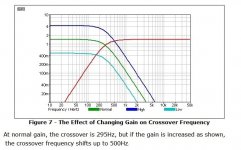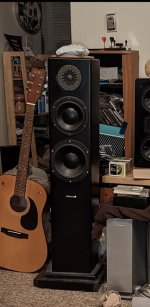Why do designers of crossovers ignore this? OK, I can understand it's a crossover.
But then builders using these on real world boxes need an extra stage to compensate for this. Why do they choose to ignore this after they have gone to the trouble of multi-amps?
Who offers a ready built PCB that can add this?
Uh, loudspeaker crossover designers don't ignore this (at all)!
Perhaps you are thinking of analog active crossovers for PA and "pro audio" use, and people who design those "dumb" boxes?
One problem, and perhaps the reason that you don't see more "solutions" for baffle step correction, is that the baffle step response is not consistent in "shape" from one speaker to another. Above the step, there are some "oscillations" (for non-spherical enclosures) in the loudspeaker's response and there is not a good general way to correct for these. One could glom on some EQ bands to a PA crossover, and then try to diddle with the individual driver levels to make things about right, but really you need to include the baffle step in the response when designing the loudspeaker crossover and address it from the beginning. I like to advocate making good measurements of the actual loudspeaker (or build a darn good response model in some way) and then tweaking the filters used in the crossovers so that they are working with the loudspeaker response. This usually means moving away from the well-known types of crossovers, since you can pretty much throw that out the window anyway. Trying to use (for instance) LR4 crossover plus some EQ and level tweaking to obtain balanced sound from your loudspeaker is probably not going to work out all that well compared to a "holistic" design.
So, as long as you have a sufficiently flexible way to implement a loudspeaker crossover (meaning not fixed order and slope with only variable frequency) then the baffle step is just another part of the loudspeaker response and the appropriate filters will take it all in without a dedicated "baffle step correction" circuit per se.
Hi Jack! 😉
I know this is an old thread, but rather than start another of the same title...
After searching, reading and asking questions, I've learned that BSC can be achieved with an active
crossover by setting the crossover at the baffle step frequency. On Rod Elliott's (E.S.P.) website he states:
" If the system is active (i.e. electronic crossover) and has a bass to mid-range crossover at the same frequency
as the baffle-step, it's just a matter of adjusting the bass level a tad higher."
My 3 way towers each have 8" woofer, 6" mid bass and 1" dome , 40" tall enclosures are ~8" wide,
for which calculations say baffle step should occur around 550Hz. I am using an analog active high pass
filter(LR 24dB/oct.), fixed @ 500Hz cutoff (closest value I have).
For the Low pass, I am using a DSP crossover@500Hz max (I can vary the frequency downward only)
and it has slopes of 24(or12)dB/Oct.
Upon Further reading on Mr. Elliott's comprehensive pages, I spotted this graph showing the effects of this very
same level (up) adjusting upon the crossover point(that we worked so hard to make symmetrical).
(Image Attached below)
So it would appear that if the woofer level is raised ~3dB to compensate for baffle step effect, the low pass "knee"
moves up in frequency, thereby raising the crossover point (but how much?) 🤔
Anyone else have experience with this phenomenon, and if so, advice on how to cross the woofer appropriately to get
a reasonably flat response in the lower mid-range?
Thanks!!
I know this is an old thread, but rather than start another of the same title...
After searching, reading and asking questions, I've learned that BSC can be achieved with an active
crossover by setting the crossover at the baffle step frequency. On Rod Elliott's (E.S.P.) website he states:
" If the system is active (i.e. electronic crossover) and has a bass to mid-range crossover at the same frequency
as the baffle-step, it's just a matter of adjusting the bass level a tad higher."
My 3 way towers each have 8" woofer, 6" mid bass and 1" dome , 40" tall enclosures are ~8" wide,
for which calculations say baffle step should occur around 550Hz. I am using an analog active high pass
filter(LR 24dB/oct.), fixed @ 500Hz cutoff (closest value I have).
For the Low pass, I am using a DSP crossover@500Hz max (I can vary the frequency downward only)
and it has slopes of 24(or12)dB/Oct.
Upon Further reading on Mr. Elliott's comprehensive pages, I spotted this graph showing the effects of this very
same level (up) adjusting upon the crossover point(that we worked so hard to make symmetrical).
(Image Attached below)
So it would appear that if the woofer level is raised ~3dB to compensate for baffle step effect, the low pass "knee"
moves up in frequency, thereby raising the crossover point (but how much?) 🤔
Anyone else have experience with this phenomenon, and if so, advice on how to cross the woofer appropriately to get
a reasonably flat response in the lower mid-range?
Thanks!!
Attachments
It is actually less complicated than you might think. In most cases, the baffle step can be compensated with a shelf filter. A first order shelf of 6 dB is a good approximation, but if you have good measurements where you have merged the near field response into the far field gated response, you can fine-tune the baffle step with a low-Q second order filter.
It is not necessary to align the crossover frequency with the baffle step frequency. A shelf filter can be put in line with both the mid and the woofer, and the two shelf filters need not be the same but instead they can be tailored for the responses of both the mid and the woofer.
It is not necessary to align the crossover frequency with the baffle step frequency. A shelf filter can be put in line with both the mid and the woofer, and the two shelf filters need not be the same but instead they can be tailored for the responses of both the mid and the woofer.
It is actually less complicated than you might think...
...It is not necessary to align the crossover frequency with the baffle step frequency. A shelf filter can be put in line with both the mid and the woofer...
Oops.
Tried to interject...
Thanks for responding; however,
I'm hoping to avoid any additional filter/circuits.
(My amps and crossovers are all built and assembled).
I have been told that the simplest (i.e. K.I.S.S.) thing is to cross over at the baffle step frequency. This will work best for my means and abilities.
Just need to configure it correctly to blend.
Any suggestions?
Thanks.
Tried to interject...
Thanks for responding; however,
I'm hoping to avoid any additional filter/circuits.
(My amps and crossovers are all built and assembled).
I have been told that the simplest (i.e. K.I.S.S.) thing is to cross over at the baffle step frequency. This will work best for my means and abilities.
Just need to configure it correctly to blend.
Any suggestions?
Thanks.
And further comment is that baffle step can be ignored completely in many instances, if I correct for baffle step it's usually by adding in a .5 woofer but I usually totally ignore it, mainly because room and floor bounce boost accounts for it quite well.
EDIT
I don't build small speakers that need stands usually
EDIT
I don't build small speakers that need stands usually
And further comment is that baffle step can be ignored completely in many instances... I usually totally ignore it, mainly because room and floor bounce boost accounts for it quite well....
Hi, thanks for responding.
Can you please help with a little context-, speaker placement:.
1.What size woofer,
2. How high off the floor,
3. How far out from the wall behind
4 How far from side walls & ceiling.
Thanks.
Mine are: 6" midbass above 500hz
8" woofer 26" from carpeted floor;
speakers placed 5 ft. out into room;
4 feet from side walls, and 6 feet apart in 14ft wide room.
BUT-
I just want to get an idea of how many dB(if any) (baffle step) level change with ~8" baffles (from treble level)and if I correct by increasing woofer levels, how much will that affect my 500hz crossover point?
I'll be happy to wait for a response that doesn't suggest redesigning my speakers or electronics
Thanks 🙏
Attachments
Last edited:
Not comparable really
10" or 12" or 15" about 70mm from floor crossing to a 10" mid-bass about 700mm above the floor All sealed and about 600mm from the back wall, It's a tri-amped 4-way.
60 / 120/ 400
Subs are modular and subject to change on a regular basis. At the moment a paired 12" plus a paired 10" in corners and no delay or boost. Tops are now sitting on top of my HT subs and this seems to be working OK
Sorry I don't think this will help you at all.
10" or 12" or 15" about 70mm from floor crossing to a 10" mid-bass about 700mm above the floor All sealed and about 600mm from the back wall, It's a tri-amped 4-way.
60 / 120/ 400
Subs are modular and subject to change on a regular basis. At the moment a paired 12" plus a paired 10" in corners and no delay or boost. Tops are now sitting on top of my HT subs and this seems to be working OK
Sorry I don't think this will help you at all.
by setting the crossover at the baffle step frequency
Actually it is in the range 0.707 to 1 x thr BS(-3). I have found number sin the lower range work better.
8” baffle width is approximately 570 Hz. 500/570 = 0.877. 570 8 0.707 = 400 Hz.
As moondog suggest sthe room and room placement can greatly complicate things.
And keep in mind that rasing on-axis to flat (if not already) will make the room response the same amount too high, so one has to listen and make a judgement
call.
BSC is not a panacea.
dave
Last edited:
Thanks, Dave.
Sounds like I may have taken what I've read about the importance of this BS too literally & need to relax & use my ears.
It would be nice to hear if anyone knows whether changing the lowpass slope from LR4 to 2nd order (HP remaining LR4) could help the situation or make things worse.
My configuration allows me to switch between analog symmetrical LR4, and DSP(12/24db/oct switchable) lowpass with compensation (including bass level trim), so I can compare and make adjustments to LF.
Thanks to all
Sounds like I may have taken what I've read about the importance of this BS too literally & need to relax & use my ears.
It would be nice to hear if anyone knows whether changing the lowpass slope from LR4 to 2nd order (HP remaining LR4) could help the situation or make things worse.
My configuration allows me to switch between analog symmetrical LR4, and DSP(12/24db/oct switchable) lowpass with compensation (including bass level trim), so I can compare and make adjustments to LF.
Thanks to all
Last edited by a moderator:
- Home
- Loudspeakers
- Multi-Way
- Active Crossovers & Baffle Step Compensation

